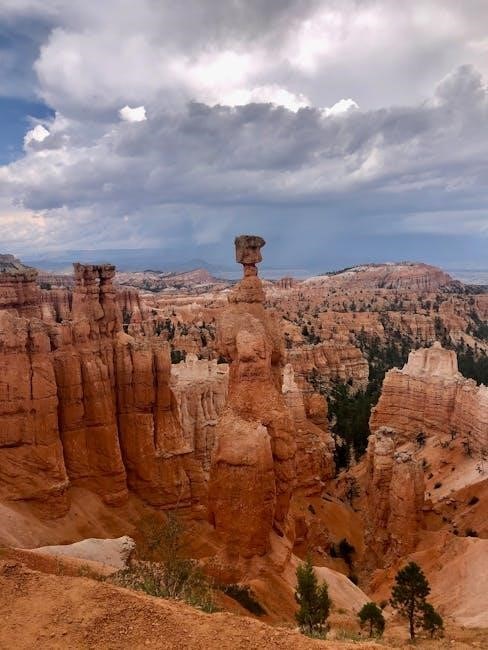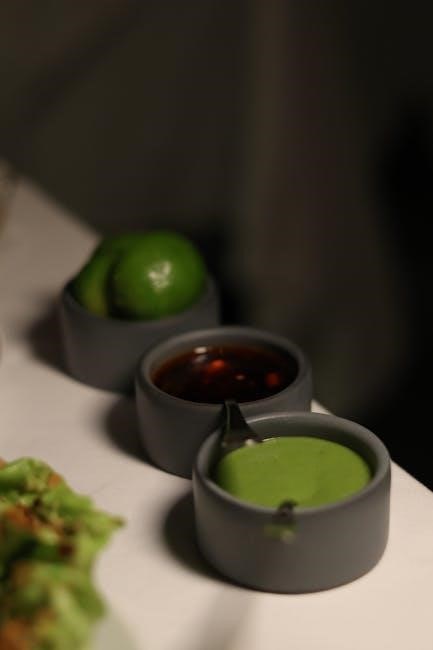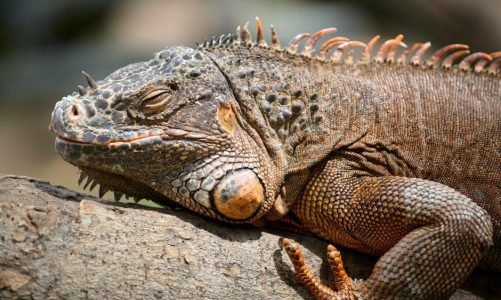Zora Neale Hurston, a renowned anthropologist and author, explored African-American folklore, particularly hoodoo, in her groundbreaking work. Hoodoo, a secretive practice blending African, Indigenous, and European traditions, was a focal point of her research, as seen in Mules and Men. Hurston’s work revealed the cultural significance of hoodoo, despite its concealment, and her writings have sparked renewed interest in understanding this profound aspect of American heritage.
1.1 Overview of Zora Neale Hurston’s Life and Work
Zora Neale Hurston, born in 1891 in Notasulga, Alabama, was a pivotal figure in the Harlem Renaissance. She studied anthropology at Barnard College under Franz Boas, which shaped her ethnographic approach to African-American culture. Hurston’s work spanned fiction, anthropology, and folklore, with her novel Their Eyes Were Watching God becoming a classic of American literature. Her anthropological studies, particularly on hoodoo, were groundbreaking, though often overlooked during her lifetime. Hurston’s legacy endured despite her financial struggles and personal challenges, with her work experiencing a resurgence in popularity in the 1970s, thanks in part to Alice Walker’s advocacy. Her contributions remain vital to understanding African-American cultural heritage and folklore traditions.
1.2 The Significance of Hoodoo in Hurston’s Research
Hoodoo held a central place in Zora Neale Hurston’s research, serving as a window into African-American spiritual and cultural practices. Through her anthropological lens, Hurston documented hoodoo rituals, beliefs, and their role in daily life, revealing its blend of African, Indigenous, and European influences. Her work emphasized hoodoo’s significance as a form of resistance and empowerment, allowing individuals to navigate racial oppression and societal challenges. Hurston’s detailed accounts, as seen in Mules and Men, highlighted the secretive nature of hoodoo, which was often hidden from mainstream society. By exploring this marginalized tradition, Hurston not only preserved its history but also challenged stereotypes, offering a nuanced understanding of its cultural and spiritual importance within African-American communities.
1.3 The Purpose of Exploring Hurston’s Work on Hoodoo
Exploring Zora Neale Hurston’s work on hoodoo is essential for understanding its cultural and historical significance in America. Her research provides a unique lens into African-American spiritual practices, blending African, Indigenous, and European traditions. By documenting hoodoo, Hurston preserved a vital part of American heritage often hidden due to secrecy and stigma. Her work challenges stereotypes and offers insights into how marginalized communities used spirituality as a form of resistance and empowerment. Hurston’s efforts not only highlight the richness of African-American culture but also underscore the importance of preserving such traditions. Her legacy continues to inspire modern scholars and enthusiasts, ensuring hoodoo’s relevance in contemporary discussions of identity and cultural preservation.

Zora Neale Hurston’s Research on Hoodoo
Zora Neale Hurston conducted extensive research on hoodoo, documenting its practices and cultural significance in the American South and beyond, despite its secretive nature.
2.1 Hurston’s Ethnographic Fieldwork in the American South
Zora Neale Hurston conducted extensive ethnographic fieldwork in the American South, immersing herself in African-American communities to document hoodoo practices. Her research, detailed in Mules and Men, captured the vibrant folklore and spiritual traditions of the rural South. Hurston traveled across the region, gathering stories, rituals, and beliefs, often gaining the trust of practitioners who shared their knowledge despite the secretive nature of hoodoo. Her work in locations like New Orleans and the Mississippi Delta provided invaluable insights into the cultural significance of hoodoo, blending anthropology with personal narratives. This fieldwork not only preserved African-American heritage but also highlighted the resilience and creativity of these communities, showcasing hoodoo as a vital part of their identity and resistance.
2.2 The Role of Hoodoo in African-American Folk Culture
Hoodoo played a pivotal role in African-American folk culture, serving as a blend of African, Indigenous, and European traditions. It was not merely a religious practice but a means of empowerment, healing, and resistance. Rooted in secrecy due to societal stigma and oppression, hoodoo allowed communities to preserve their cultural identity and address daily challenges. Hurston’s work highlights how hoodoo practitioners, often respected figures, used rituals, herbs, and spiritual knowledge to maintain balance and provide solutions. This practice fostered resilience and unity, embodying the enduring legacy of African diasporic traditions in America. Hoodoo’s significance lies in its ability to adapt and thrive, reflecting the resourcefulness and strength of African-American communities.
2.3 Hurston’s Methods of Documenting Hoodoo Practices
Zora Neale Hurston employed immersive fieldwork to document hoodoo practices, gaining the trust of practitioners in the American South and West. She participated in rituals, observed spells, and recorded stories, ensuring authenticity. Hurston’s methods included transcribing interviews, noting symbolic rituals, and preserving oral traditions. Her work in Mules and Men showcased hoodoo’s cultural significance, blending anthropology with storytelling. By presenting these practices respectfully, Hurston aimed to demystify hoodoo, highlighting its role in African-American life. Her documentation remains a vital resource, offering insights into the spiritual and social dynamics of hoodoo, while respecting its secretive nature and the privacy of its practitioners.

Hoodoo in America: Historical Context
Hoodoo in America traces back to African traditions, blended with Native American and European influences. It became a vital part of African-American culture, providing spiritual and communal support. Mainstream society often misunderstood it, leading to marginalization despite its importance in preserving heritage.
3.1 The Origins of Hoodoo in African and Indigenous Traditions
Hoodoo’s roots lie in African diasporic religions, blending spiritual practices from West and Central Africa with Indigenous American traditions. Enslaved Africans brought their rituals, herbalism, and beliefs to the Americas, merging them with Native American healing practices. This fusion created a unique system focused on spirituality, healing, and protection. Hoodoo incorporated elements like rootwork, conjuring, and ancestor reverence, reflecting both African and Native American influences; Zora Neale Hurston’s research highlights how these traditions adapted to the harsh realities of slavery and segregation, becoming a source of resilience and cultural preservation for African-Americans. Her work underscores the importance of understanding Hoodoo as a dynamic, evolving practice deeply tied to its African and Indigenous origins.
3.2 The Evolution of Hoodoo in the Southern United States
Hoodoo in the Southern United States evolved as a blend of African, Indigenous, and European influences, shaped by the region’s history and culture. Enslaved Africans brought their spiritual practices, which merged with Native American traditions and Christian elements. Over time, Hoodoo became a unique system emphasizing spiritual healing, protection, and empowerment. Rootwork, a central practice, utilized local plants for rituals and remedies. Hoodoo also served as a means of resistance and survival during slavery and segregation. In the rural South, practitioners, often respected community figures, used Hoodoo for healing, divination, and solving problems. Urbanization and migration spread Hoodoo beyond the South, adapting it to new environments while preserving its essence. Hurston’s work documents this evolution, highlighting Hoodoo’s resilience and its role in African-American culture.
3.3 Hoodoo as a Form of Resistance and Empowerment
Hoodoo served as a powerful form of resistance and empowerment for African-Americans, particularly during slavery and segregation. It allowed individuals to reclaim agency over their lives, offering spiritual and emotional strength. Rooted in ancestral traditions, Hoodoo provided a means to challenge oppression while maintaining cultural identity. Practitioners used rituals and spells not only for healing but also to resist systemic racism and assert autonomy. Hurston’s work highlights how Hoodoo fostered resilience, enabling communities to navigate oppressive systems. By preserving African diasporic traditions, Hoodoo became a symbol of resistance and self-determination, empowering individuals to confront adversity and assert their humanity in the face of systemic inequality. Hurston’s documentation underscores its role in fostering collective strength and cultural pride.

Key Themes in Hurston’s Work on Hoodoo

Zora Neale Hurston’s work on Hoodoo explores themes of spiritual practices, cultural preservation, and empowerment, blending African and Indigenous traditions with African-American identity and resilience.
4.1 The Intersection of Religion and Magic in Hoodoo
Zora Neale Hurston’s work on Hoodoo highlights the seamless blend of religious and magical practices, showcasing Hoodoo as a spiritual system deeply intertwined with daily life. In her research, Hurston illustrates how Hoodoo practitioners often combined elements of Christianity with African diasporic traditions, creating a unique syncretic practice. This intersection reflects the adaptive nature of African-American culture, where religious beliefs and magical rituals coexist to address both spiritual and practical needs. Hurston’s documentation reveals Hoodoo as a holistic practice, emphasizing its role in healing, protection, and divine communication. By exploring this duality, Hurston sheds light on the resilience and creativity of African-Americans in preserving their cultural identity through spiritual practices. Her work underscores the significance of Hoodoo as a reflection of communal faith and empowerment.
4.2 The Role of the Hoodoo Practitioner in the Community
Zora Neale Hurston’s research emphasizes the pivotal role of Hoodoo practitioners as spiritual and cultural advisors within African-American communities. These practitioners, often respected for their wisdom and supernatural knowledge, served as mediators between the spiritual and physical worlds. They addressed issues such as health, relationships, and protection, blending magical and religious elements to provide solutions. Hurston’s work highlights their dual role as both healers and counselors, illustrating their importance in maintaining communal harmony. By documenting their practices, Hurston underscores the practitioner’s status as a vital figure, bridging the sacred and the mundane. Their influence extended beyond individual concerns, shaping cultural identity and fostering resilience in the face of adversity.
4.3 The Symbolism and Rituals of Hoodoo Practices
Zora Neale Hurston’s work explores the rich symbolism and rituals embedded in Hoodoo practices, which are deeply rooted in African and Indigenous traditions. Rituals often involve the use of herbs, roots, and charms, each carrying specific meanings tied to their origins and purposes. For instance, certain roots symbolize protection, while others represent love or prosperity. Hurston documents how these elements are combined in precise ceremonies, often performed at specific times, such as during the full moon or at crossroads, believed to amplify their power. These rituals not only address individual needs but also serve to connect practitioners with ancestral spirits and communal traditions, reinforcing Hoodoo’s role as a bridge between the physical and spiritual realms.
Zora Neale Hurston’s Major Works on Hoodoo
Zora Neale Hurston’s works, like “Mules and Men” and “Their Eyes Were Watching God,” showcase her deep exploration of Hoodoo traditions and their cultural significance.
5.1 “Mules and Men” as a Collection of Folktales and Hoodoo Stories
Zora Neale Hurston’s Mules and Men is a seminal work that captures African-American folklore, including Hoodoo traditions, through a collection of stories, rituals, and beliefs. Published in 1935, the book is a result of Hurston’s extensive fieldwork in the Southern United States, where she immersed herself in communities to document their cultural practices. The text blends ethnography with storytelling, offering insights into the spiritual and magical dimensions of Hoodoo. Hurston’s approach emphasized authenticity, as she often participated in rituals and interviewed practitioners to gather firsthand accounts. Mules and Men not only preserves Hoodoo traditions but also highlights their significance within African-American culture, making it a cornerstone of Hurston’s research on the subject.
5.2 The Representation of Hoodoo in “Their Eyes Were Watching God”
Zora Neale Hurston’s novel Their Eyes Were Watching God subtly incorporates elements of Hoodoo, reflecting its cultural significance in African-American life. While not the central focus, Hoodoo influences the characters’ beliefs and actions, particularly in moments of crisis or transformation. Janie’s journey, for instance, intersects with folk traditions that blend spirituality and magic. Hurston’s portrayal of Hoodoo in the novel is more nuanced and less explicit than in Mules and Men, yet it underscores the enduring presence of these practices in everyday life. The novel highlights how Hoodoo, as part of African-American folklore, shapes identity and resilience, aligning with Hurston’s broader exploration of cultural preservation and authenticity.
5.3 Other Writings and Lectures on Hoodoo by Hurston

Beyond her major works, Zora Neale Hurston produced numerous essays, lectures, and unpublished manuscripts that delve into Hoodoo. These writings showcase her deep anthropological curiosity and commitment to documenting African-American folklore; In her lectures, Hurston often emphasized the cultural significance of Hoodoo, framing it as a vital aspect of Black identity and resilience. Her essays, such as those published in journals during the Harlem Renaissance, provide additional insights into her research methods and interpretations of Hoodoo practices. These lesser-known works highlight Hurston’s interdisciplinary approach, blending anthropology, literature, and sociology to capture the complexity of Hoodoo. They also reveal her efforts to challenge stereotypes and present Hoodoo as a sophisticated, meaningful tradition. Hurston’s lectures and writings remain invaluable for understanding her comprehensive vision of African-American cultural life.

The Modern Relevance of Hurston’s Work on Hoodoo
Zora Neale Hurston’s work on Hoodoo remains relevant today, offering insights into African-American cultural heritage and identity. Her writings, including “Zora Neale Hurston Hoodoo in America PDF,” resonate with contemporary scholars and enthusiasts, bridging history and modernity.
6.1 The Renewed Interest in Hurston’s Work in the 21st Century
Zora Neale Hurston’s work on Hoodoo has experienced a resurgence of interest in the 21st century, driven by a growing appreciation for African-American cultural heritage. Scholars and enthusiasts alike are revisiting her research, particularly through accessible formats like the “Zora Neale Hurston Hoodoo in America PDF,” which offers a comprehensive look at her findings. This renewed attention highlights the timeless relevance of her anthropological studies, bridging historical and contemporary perspectives. Hurston’s work not only preserves Hoodoo traditions but also fosters a deeper understanding of its cultural significance. As a result, her contributions continue to inspire new generations, sparking fresh discussions about identity, spirituality, and the African diaspora.
6.2 The Influence of Hurston’s Hoodoo Research on Contemporary Culture
Zora Neale Hurston’s Hoodoo research has significantly influenced contemporary culture, inspiring artists, writers, and scholars to explore African-American spiritual traditions. Her work, particularly through the Zora Neale Hurston Hoodoo in America PDF, has sparked renewed interest in Hoodoo’s cultural and historical significance. Modern filmmakers, musicians, and authors draw inspiration from her ethnographic studies, incorporating elements of Hoodoo into their creations. This resurgence highlights Hoodoo’s relevance in today’s conversations about identity, spirituality, and cultural preservation. Hurston’s documentation of Hoodoo practices has also fostered a deeper appreciation for African diasporic traditions, making her research a cornerstone of contemporary cultural discourse and creative expression.
6.3 The Digital Availability of Hurston’s Work, Including “Zora Neale Hurston Hoodoo in America PDF”
Zora Neale Hurston’s work on Hoodoo is now widely accessible through digital platforms, including the Zora Neale Hurston Hoodoo in America PDF. This digital availability has made her research reachable to a global audience, fostering academic and casual interest in African-American folk traditions. Online archives, libraries, and educational platforms host her writings, ensuring her contributions remain relevant in the digital age. This accessibility has also enabled new generations of scholars and enthusiasts to explore Hoodoo’s cultural significance, further cementing Hurston’s legacy as a pioneering anthropologist and writer. The digital format has also facilitated easier sharing and study of her work, ensuring its enduring impact on contemporary discussions of Hoodoo and its history.
The Cultural Significance of Hoodoo in America
Hoodoo in America reflects African-American identity, blending African traditions with indigenous practices. It symbolizes resilience, spirituality, and cultural preservation, offering empowerment through rituals and beliefs deeply rooted in heritage.
7.1 Hoodoo as a Reflection of African-American Identity
Hoodoo in America serves as a profound reflection of African-American identity, embodying the blending of African, European, and Native American cultural practices. It represents the resilience and creativity of African-Americans, who, despite the trauma of slavery and systemic oppression, preserved and transformed their ancestral traditions. Hoodoo became a means of spiritual resistance, offering empowerment through rituals, spells, and herbalism. Zora Neale Hurston’s work, particularly in “Mules and Men,” highlights how Hoodoo practices were deeply intertwined with daily life, folklore, and community identity. By documenting these traditions, Hurston not only preserved African-American cultural heritage but also showcased its significance as a unique expression of Black identity in America.

7.2 The Role of Hoodoo in Preserving African Diasporic Traditions
Hoodoo played a crucial role in preserving African Diasporic traditions by blending African, European, and Indigenous American practices. Despite the disruption caused by the transatlantic slave trade, enslaved Africans managed to retain and adapt their spiritual beliefs. Hoodoo became a vessel for preserving these traditions, incorporating elements like herbalism, divination, and ancestor reverence. Zora Neale Hurston’s work, as seen in “Mules and Men,” documented these practices, illustrating how Hoodoo sustained cultural continuity. By maintaining these traditions, African-Americans connected with their ancestral heritage, ensuring the survival of their cultural identity amidst oppression. Hurston’s research underscores Hoodoo’s importance in safeguarding the rich tapestry of African Diasporic traditions.
7.3 The Misrepresentation of Hoodoo in Popular Culture
Hoodoo has often been misrepresented in popular culture, frequently conflated with Voodoo or portrayed as dark magic. These depictions ignore its roots as a spiritual and healing practice deeply connected to African Diasporic traditions. Zora Neale Hurston’s work challenges these stereotypes by presenting Hoodoo as a legitimate system of belief and practice. However, media and literature often sensationalize Hoodoo, reducing it to caricatures or supernatural elements. This misrepresentation perpetuates misunderstanding and marginalizes its cultural significance. Hurston’s research, as highlighted in “Mules and Men,” provides a counter-narrative, emphasizing Hoodoo’s role in African-American communities and its connection to ancestral traditions. Accurate representation is essential to honoring its cultural legacy.
The Historical Context of Hurston’s Research
Zora Neale Hurston’s research on Hoodoo was shaped by the cultural and social dynamics of the early 20th century, including the Harlem Renaissance and racial tensions.
8.1 The Harlem Renaissance and Its Impact on Hurston’s Work
The Harlem Renaissance, a cultural and intellectual movement in the 1920s and 1930s, profoundly influenced Zora Neale Hurston’s work on Hoodoo. This era celebrated African-American identity, providing Hurston with a platform to explore and document Black folk culture. Her involvement with prominent figures like Langston Hughes and Alain Locke encouraged her anthropological research. The Renaissance’s emphasis on racial pride aligned with Hurston’s goal of preserving African-American traditions, including Hoodoo. This period shaped her approach to blending storytelling and scholarship, as seen in Mules and Men. Hurston’s work during this time not only reflected the cultural vibrancy of the Harlem Renaissance but also challenged stereotypes, offering an authentic representation of Black life and traditions.
8.2 The Racial and Gender Bias Hurston Faced in Her Career
Zora Neale Hurston faced significant racial and gender bias throughout her career, which impacted her recognition and opportunities. As a Black woman in a predominantly white, male-dominated academic and literary world, she encountered skepticism and marginalization. Her work on Hoodoo, in particular, was often dismissed as “superstition” by scholars who did not value African-American folk traditions. Additionally, Hurston’s independence and strong personality led to conflicts with patrons and peers, further complicating her professional journey. Despite these challenges, Hurston remained committed to her research, using her unique voice to challenge stereotypes and celebrate Black culture. Her resilience in the face of bias has become a testament to her enduring legacy.
8.3 The Legacy of Hurston’s Work in the Context of American Anthropology
Zora Neale Hurston’s work has left a profound legacy in American anthropology, particularly in the study of African-American culture and folklore. Her groundbreaking research on Hoodoo and other traditions challenged Eurocentric perspectives, offering a nuanced understanding of Black cultural practices. Hurston’s anthropological methods, which emphasized immersion and storytelling, influenced later scholars to adopt more inclusive approaches. Her work bridged anthropology and literature, creating a model for interdisciplinary research. While her contributions were underappreciated during her lifetime, Hurston’s legacy now stands as a cornerstone of American anthropology, inspiring new generations to explore the richness of African diasporic traditions with respect and depth.
Zora Neale Hurston’s work on Hoodoo in America remains a vital contribution to cultural and anthropological studies, preserving African-American traditions and inspiring future generations to explore and appreciate their rich heritage.
9.1 The Enduring Legacy of Zora Neale Hurston’s Research on Hoodoo
Zora Neale Hurston’s research on Hoodoo in America has left an indelible mark on anthropological and cultural studies. Her meticulous documentation of Hoodoo practices, as seen in works like Mules and Men, has preserved a vital aspect of African-American folklore. Hurston’s work not only challenged stereotypes but also highlighted the richness and complexity of Black cultural traditions. Her legacy endures as a cornerstone for understanding the intersection of spirituality, identity, and resilience in African-American communities. By bridging academia and lived experience, Hurston’s research continues to inspire scholars and enthusiasts alike, ensuring that Hoodoo’s history and significance remain accessible and relevant for future generations.
9.2 The Importance of Preserving Hoodoo Traditions in Modern America

Preserving Hoodoo traditions in modern America is crucial for honoring African-American cultural heritage and fostering cross-cultural understanding. Hoodoo, rooted in African and Indigenous practices, serves as a vital link to ancestral traditions, offering insights into resilience, spirituality, and community healing. By safeguarding these practices, we ensure that future generations can learn from and appreciate the richness of African diasporic traditions. Additionally, preserving Hoodoo challenges stereotypes and misrepresentations, promoting a more accurate understanding of its role in American history. Efforts to document and celebrate Hoodoo, as seen in Hurston’s work, highlight its enduring relevance and the need to protect this cultural treasure for years to come.
9.3 Final Thoughts on the Significance of Hurston’s Contributions

Zora Neale Hurston’s contributions to the study of Hoodoo and African-American culture remain unparalleled. Her work, particularly in “Mules and Men” and “Their Eyes Were Watching God,” has preserved invaluable traditions and stories, ensuring their survival for future generations. Hurston’s anthropological approach not only documented Hoodoo practices but also humanized them, countering stereotypes and misconceptions. Her legacy endures as a testament to the richness of African diasporic traditions and their enduring relevance in modern America. By bridging the past and present, Hurston’s work continues to inspire scholars, artists, and the general public, cementing her role as a pioneering figure in American cultural and anthropological history.



